In Windows 8 and Windows 10, there is a feature called Fast Startup to speed up the boot process. When enabled, it makes Windows boot very fast. The operating system uses a hybrid shutdown which writes the memory occupied by the OS kernel and loaded drivers to the C:\hiberfil.sys file. Unlike full hibernation, it discards the user session by logging out the user. On the next boot, it restores the saved information to RAM immediately but loads a fresh user session. In this article, we'll see how to disable full hibernation to save disk space but keep fast startup.
Advertisеment
When you disable hibernation completely, it disables the Fast Startup feature too. Obviously, Fast Startup depends on hibernation and cannot work without it.
However, in many cases, users want to disable hibernation to save disk space on the partition where Windows is installed. The hibernation file consumes at least half the amount of disk space even if you compress it. In Windows 10, there is an additional option you can use to save disk space without completely turning off hibernation. We already reviewed the first method in the following article:
Compress Hibernation File in Windows 10
An alternative is to change the hibernation type. Thanks to the ability to switch the hibernation type from full to reduced, you can keep the Fast Startup feature turned on but save a considerable amount of disk space by disabling full hibernation. It still keeps the hiberfil.sys but its size is reduced. So Windows 10 supports two hibernation types: Full and Reduced. Here is how you can switch between them.
Disable Hibernation but Keep Fast Startup
Do the following.
- Open an elevated command prompt.
- Type or paste the following command
powercfg /h /type reduced
This command will reduce the hibernation file size for storing only the OS kernel and drivers for Fast Startup.
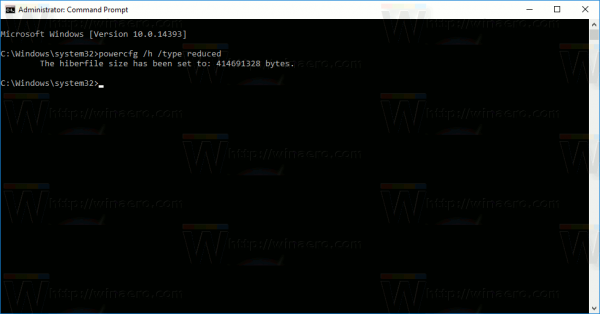 If some day, you decide to restore the default hibernation configuration, the following command will restore it for you:
If some day, you decide to restore the default hibernation configuration, the following command will restore it for you:
powercfg /h /type full
The size of the hiberfil.sys file will be restored. The operating system will enable the hibernation file to store the full contents of memory.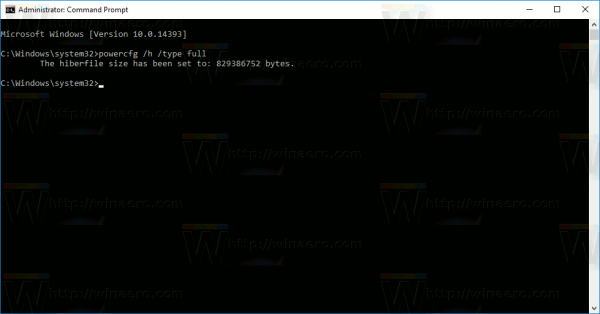
Full Hibernation supports storing the state of all opened apps, files, drivers etc - everything is restored as it was. This process is still much faster than a cold start of the operating system. But as mentioned above, it takes at least 40% of the installed memory's space on the drive.
The reduced hibernation type keeps only enough data to store the non-user session (kernel) state. The C:\hiberfil.sys will take only 20% of the installed RAM. It is not possible to use the Hibernate command in the reduced mode, it will disappear from the Start menu and the Power menu in Win + X.
Tip: If you compressed your hibernation file earlier, the powercfg /h /type reduced command can give you an error "The parameter is incorrect".
To avoid this, try to uncompress the hibernation file using this command:
powercfg hibernate size 0
Then run the command to use the reduced hibernation file.
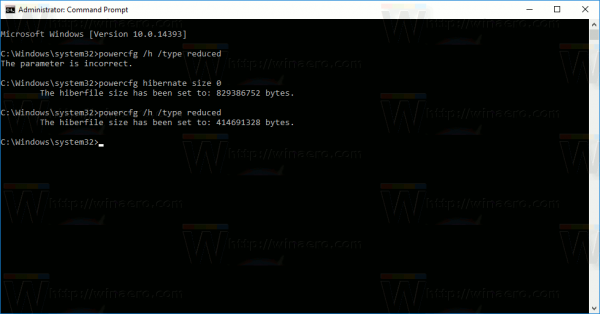 This should resolve the issue for you.
This should resolve the issue for you.
To automate these tasks, you can use Winaero Tweaker. The approprite GUI can be found under Behavior\Hibernation.
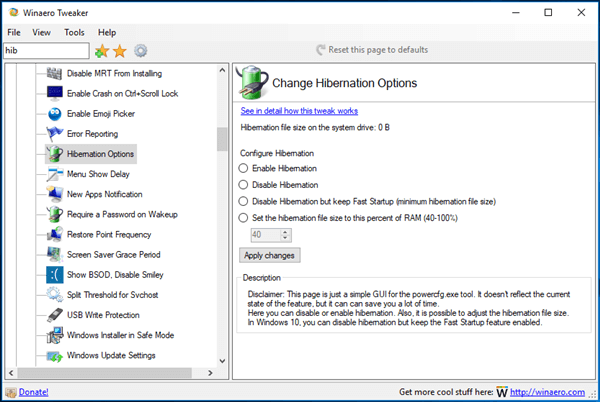
You can download Winaero Tweaker here:
That's it.
Support us
Winaero greatly relies on your support. You can help the site keep bringing you interesting and useful content and software by using these options:
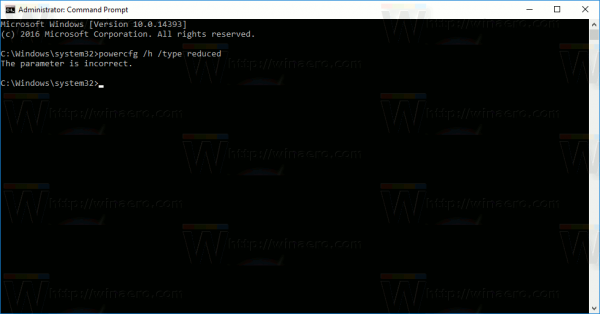

Useful tip. Thanks.
Also, when you set the hibernation file to 50%, i think instead of actually compressing file, OS reduces the list of files to be included in it.
Cause, compressing and decompressing operations would otherwise be noticeable during hibernation and restore.
I’ve had my entire Windows 10 system rendered unusable (reboots constantly present INACCESSIBLE_BOOT_DEVICE BSOD) thanks to Fast Startup. I’d recommend disabling it immediately or you risk a very nasty aftermath. For me, the Windows 10 ‘reset’ feature was my best guess choice and it’s a joke: nukes everything in program files and appdata, leaving only the user account and user’s stored files (not settings) in place. I don’t call that a reset. I call that a re-install ‘over the top’ of an existing windows installation … and we all know from history how useless that is!
Further observation is that if you use the Hibernate command from command line or third party Start menu when using /reduced hiberfil.sys (on my 8 GB RAM laptop, the reduced hiberfile.sys is just 1.50 GB ), it sends the PC to Sleep.
Thank you very much for this information.
Well, its good for my small 2in1 but doing this on my laptop has serious issue that it doesn’t shutdown even after waiting for many minutes.Forcing shutdown starts from cold boot next time.Sfc and chkdsk also doesn’t solve this issue.Only reverting back to normal solves this issue
Should i disable hiber for SSD drives?
You should not disable it
What about Windows 7 (64) hibernation?
I cannot find a best possible setting than completely disable hibernation. But, even with disabling it I’m getting strange BSODs based on memory faults.
* “mdsched.exe” (memory test) (6GB RAM [CH1=2+2GB, CH2=1+1GB]), says was ok.
* “chkdsk”, ok.
* “sfc /scannow”, ok.
As Windows 7 do not support “powercfg /h /type reduced”, what you think is the next solution?
Winaero remains the Best.
Thanks
Hello Antony.
First of all, thanks for your kind words. Much appreciated.
On your issue, it must be something specific to your device.
Here, I disable hibernation on Windows 7 without issues, I have never run into BSODs after disabling it.
Could you please try with clean boot? The steps are nearly the same for Windows 7.